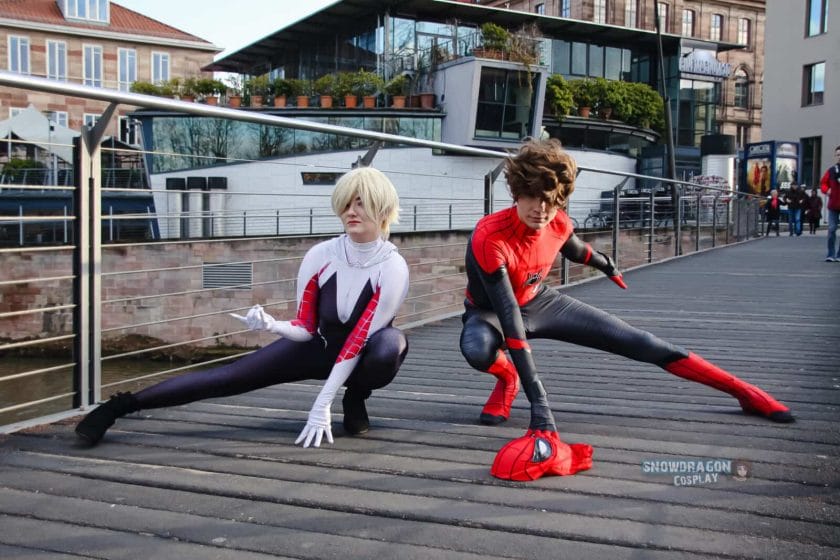[publishpress_authors_box layout="ppma_boxes_840322"]

1. What is Shibari cosplay and how does it differ from traditional cosplay techniques?
Understanding Shibari Cosplay
Shibari cosplay, also known as rope bondage cosplay, is a unique and visually striking form of cosplay that incorporates the art of Japanese rope bondage into costume design. It involves using ropes to create intricate patterns and designs on the body, enhancing the overall aesthetic of the character being portrayed.
Differences from Traditional Cosplay Techniques
While traditional cosplay focuses on creating costumes that closely resemble the appearance of a character, Shibari cosplay takes a more artistic approach by incorporating rope as an integral part of the costume design. This technique adds an additional layer of complexity and creativity to the overall cosplay concept.
Unlike traditional methods that primarily involve fabric, sewing, and prop-making skills, Shibari cosplay requires knowledge and expertise in various knotting techniques used in rope bondage. The cosplayer must have a solid understanding of different types of knots, their purpose, and how they can be combined to create visually appealing designs.
In terms of execution, traditional cosplay often involves sewing or crafting costumes using materials like fabric, foam, or worbla. In contrast, Shibari cosplay requires careful placement and tying of ropes onto the body to achieve desired shapes and patterns. This technique demands precision and attention to detail to ensure both comfort and safety for the wearer.
Overall, while both traditional cosplay and Shibari cosplay share the goal of bringing characters to life through visual representation, Shibari adds an element of sensuality and artistic expression through its use of rope bondage techniques.
2. The Origins and Evolution of Shibari: A Look into the Practice Over Time
The Ancient Roots
Shibari has its roots in ancient Japan, where it was originally practiced as a form of martial arts and restraint. It dates back to the Edo period (1603-1868) when it was used by samurais for capturing and restraining prisoners. Over time, Shibari evolved into an art form that focused on aesthetics and the beauty of rope patterns.
Modern Influence
In the 20th century, Shibari gained popularity outside of Japan through various artistic movements. The influential photographer Nobuyoshi Araki played a significant role in introducing Shibari to the Western world through his erotic photography series. This exposure led to an increased interest in Shibari as an art form and its incorporation into different creative fields, including cosplay.
Shibari in Cosplay
The introduction of Shibari into cosplay brought a new dimension to character portrayal. Cosplayers started using rope bondage techniques to enhance their costumes and create visually stunning designs that showcased both their creativity and attention to detail.
As Shibari cosplay continues to evolve, cosplayers are pushing boundaries by incorporating elements from different cultures and experimenting with new materials. This fusion allows for even more diverse interpretations of characters while still paying homage to the traditional roots of Shibari.
Overall, the practice of Shibari has come a long way from its origins as a martial art technique. It has transformed into a visually captivating form of self-expression that is embraced by cosplayers around the world.
3. Enhancing Character Design with Rope: Exploring the Role of Shibari in Cosplay
Understanding the Art of Shibari
Shibari, also known as Japanese rope bondage, is an ancient art form that has gained popularity in the world of cosplay. It involves intricately tying ropes around a person’s body to create visually stunning designs and patterns. The technique not only adds aesthetic appeal to cosplay costumes but also allows cosplayers to enhance their character portrayals by embodying the essence of their chosen characters through rope.
The Symbolism Behind Shibari
One of the fascinating aspects of using Shibari in cosplay is the symbolism behind it. In Japanese culture, rope has various meanings such as protection, restraint, and connection. By incorporating Shibari into cosplay, cosplayers can convey these symbolic meanings through their characters’ designs. For example, a character who is portrayed as powerful and dominant may have intricate rope patterns that signify control and strength.
– Rope as a visual representation of character traits
– Symbolic meanings behind different types of knots
4. Safety First: Important Considerations When Incorporating Rope into Cosplay Costumes
Risk Assessment and Preparation
Before incorporating rope into a cosplay costume, it is crucial to prioritize safety to ensure a comfortable and secure experience for both the cosplayer and anyone involved in the process. Conducting a thorough risk assessment is essential to identify potential hazards and take necessary precautions.
Choosing High-Quality Rope Materials
Selecting suitable rope materials is another important consideration when incorporating rope into cosplay costumes. Opting for high-quality ropes that are specifically designed for Shibari ensures durability and reduces the risk of accidents or discomfort during wear.
– Conducting risk assessments before starting any ropework
– Ensuring proper padding or protection for sensitive areas
5. Recommended Types of Rope for Shibari Cosplay: Choosing the Right Material
Natural Fiber Ropes
When it comes to choosing the right rope for Shibari cosplay, natural fiber ropes are often preferred due to their aesthetic appeal, flexibility, and comfort. Common natural fiber options include jute, hemp, and cotton ropes.
Considerations for Synthetic Ropes
While natural fiber ropes are popular choices, synthetic ropes also have their advantages. They tend to be more resistant to wear and tear, making them suitable for intense or outdoor cosplay events. However, cosplayers should carefully consider the specific needs of their costumes before opting for synthetic ropes.
– Pros and cons of different types of natural fiber ropes
– Factors to consider when choosing between natural and synthetic ropes
6. From Anime to Video Games: Popular Characters Brought to Life with Shibari Techniques
Exploring the Intersection of Shibari and Anime/Videogame Cosplay
In recent years, shibari techniques have gained popularity among cosplayers who want to bring their favorite anime and video game characters to life in a unique way. By incorporating rope bondage into their costumes, cosplayers can add an extra layer of authenticity and creativity to their portrayals. Whether it’s recreating iconic poses or capturing the essence of a character’s personality, shibari offers endless possibilities for cosplayers looking to stand out at conventions.
Examples of Shibari-Enhanced Cosplays
- A popular example is the use of shibari in cosplaying characters from the “Attack on Titan” series. By using ropes strategically placed on their costumes, cosplayers can mimic the look of the vertical maneuvering equipment used by the characters in the show.
- In video game cosplay, shibari techniques have been used to recreate intricate armor designs from games like “Dark Souls” or “Final Fantasy.” The ropes not only add visual interest but also help create a sense of realism and texture.
7. Crafting Characters with Rope: How Shibari Differs from Traditional Costume-Making Methods
The Artistic Approach of Shibari in Costume Design
Shibari differs significantly from traditional costume-making methods due to its focus on rope as both a functional element and an artistic medium. While traditional costume-making often involves fabric manipulation and sewing techniques, shibari allows cosplayers to explore sculptural elements and create visually striking designs using knots and patterns.
The Role of Rope Materials in Shibari Cosplay
When it comes to shibari cosplay, the choice of rope materials is crucial. Natural fibers like jute or hemp are commonly used due to their strength and flexibility. These materials not only provide durability but also enhance the overall aesthetic of the costume, giving it an authentic and textured appearance.
8. Cultural and Historical Influences on Shibari in Cosplay: Unveiling its Roots
The Origins of Shibari and its Connection to Japanese Culture
Shibari has deep roots in Japanese culture, specifically within the art of kinbaku, which translates to “tight binding.” Kinbaku originated as a form of erotic bondage in Japan during the Edo period (1603-1868) and has since evolved into a respected art form. The influence of kinbaku can be seen in modern shibari cosplay, where practitioners pay homage to its historical significance while incorporating elements from anime and video game fandoms.
The Evolution of Shibari Cosplay: Fusion of Traditional and Contemporary Elements
In contemporary shibari cosplay, cosplayers blend traditional kinbaku techniques with modern costume design principles. This fusion allows for a unique expression of cultural heritage while celebrating popular characters from various media. By combining these influences, shibari cosplay becomes a powerful representation of both historical traditions and contemporary creativity.
9. Overcoming Challenges in Shibari Cosplay: Common Obstacles and Solutions
Navigating Practical Issues in Shibari Cosplay
While shibari cosplay offers exciting possibilities for character portrayal, it also presents certain challenges that cosplayers must overcome. One common obstacle is achieving proper tension and balance when tying knots, especially when incorporating complex designs into costumes. Additionally, ensuring comfort and mobility for the cosplayer throughout the event can be a challenge due to the restrictive nature of some shibari techniques.
Tips for Successful Shibari Cosplay
- Practice makes perfect: It’s essential to dedicate time to learn and master different shibari knots and techniques before incorporating them into cosplay designs. This will ensure better execution and reduce the risk of discomfort during events.
- Collaboration is key: Working with a partner or experienced rigger can help overcome technical challenges and ensure safety in shibari cosplay. Their expertise can provide guidance on achieving proper tension, balance, and comfort for the cosplayer.
10. Beginner’s Guide to Shibari Knots: Essential Techniques for Cosplay Enthusiasts
For cosplay enthusiasts interested in exploring shibari techniques, mastering basic knots is crucial. These knots serve as building blocks for more complex designs and allow cosplayers to create visually captivating rope patterns that enhance their costumes.
Common Shibari Knots for Cosplay
- The Single Column Tie: This knot forms a secure anchor point on the body, often used to attach ropes to different parts of a costume or create suspension points.
- The Two-Column Tie: This knot involves tying two parallel columns around a limb or object, providing stability and support while maintaining flexibility.
- The Diamond Harness: A more intricate knot that creates an appealing diamond-shaped pattern on the body, adding visual interest to the cosplay design.
11. Prioritizing Comfort and Mobility in Shibari Cosplay Design: Ensuring a Wearable Costume
Designing Shibari Cosplays with Comfort in Mind
When incorporating shibari techniques into cosplay designs, it’s essential to prioritize the comfort and mobility of the cosplayer. Unlike traditional costumes, shibari-enhanced designs involve ropes that can restrict movement if not carefully planned and executed.
Tips for Comfortable Shibari Cosplay
- Consider the wearer’s range of motion: Design costumes with strategically placed ropes that allow for natural movement without causing discomfort or limitations.
- Use padding and cushioning: Incorporate padding or cushioning materials between the ropes and the body to provide additional comfort and minimize pressure points.
- Choose breathable fabrics: Opt for lightweight, breathable fabrics for the costume itself to prevent overheating or excessive sweating during extended wear.
12. Achieving Realistic Rope Designs Safely: Tips and Tricks for Authenticity in Cosplay
Safety Precautions in Shibari Cosplay
While authenticity is important in shibari cosplay, ensuring safety should always be a top priority. It’s crucial to approach rope usage with caution and take necessary precautions to avoid injury or discomfort during cosplay events.
Risk Mitigation Strategies
- Properly educate yourself: Attend workshops, seek guidance from experienced riggers, or join communities dedicated to shibari cosplay to learn about safe practices and techniques.
- Regularly check for circulation: Regularly assess the cosplayer’s comfort and circulation by monitoring their limbs’ coloration, temperature, and sensation.
- Create quick-release mechanisms: Implement quick-release mechanisms or have emergency shears readily available to ensure a swift release from any potentially uncomfortable or dangerous situations.
13. Adding Depth to Characters through Shibari: Exploring Backstories and Personalities in Cosplay
The Art of Storytelling in Shibari Cosplay
Shibari can be more than just a visually striking addition to cosplay; it can also serve as a tool for character development and storytelling. By incorporating shibari techniques into their costumes, cosplayers have the opportunity to explore their characters’ backstories, personalities, and relationships in a unique and creative way.
Using Shibari as Symbolism
Certain shibari patterns or placements can symbolize different aspects of a character’s journey or personality. For example, intricate knots may represent complex emotions, while ropes strategically wrapped around specific body parts could signify strength or vulnerability. By carefully selecting and designing shibari elements, cosplayers can add depth and meaning to their portrayals.
14. Ethical Considerations in Shibari Cosplay: Respecting Boundaries and Consent
The Importance of Communication and Consent in Shibari Cosplay
Due to the intimate nature of shibari techniques, ethical considerations regarding consent become paramount when incorporating them into cosplay. It is essential for all parties involved to establish clear boundaries, communicate openly, and obtain explicit consent before engaging in any shibari-related activities.
Educating Yourself on Consent Culture
Prioritize educating yourself on consent culture by attending workshops or engaging with resources that focus on fostering healthy communication and understanding boundaries. This knowledge will help create a safe and respectful environment for both the cosplayer and anyone involved in the shibari process.
15. The Rise of Shibari Cosplay: Trends, Innovations, and Future Directions
Exploring the Growing Popularity of Shibari Cosplay
In recent years, shibari cosplay has gained significant attention within the cosplay community. Its unique blend of traditional Japanese artistry and contemporary character portrayals has captivated cosplayers and enthusiasts alike.
Emerging Trends and Innovations
- Collaborative shibari cosplays: More cosplayers are teaming up with experienced riggers or partners to create elaborate shibari-enhanced designs that push the boundaries of creativity.
- Incorporating technology: Some cosplayers have started integrating LED lights or other technological elements into their shibari designs, enhancing the visual impact and creating a futuristic twist.
The Future of Shibari Cosplay
The future of shibari cosplay holds endless possibilities for further innovation and exploration. As more individuals become interested in this unique form of expression, it is likely that we will see continued growth in techniques, materials, and collaborations within the shibari cosplay community.
In conclusion, Shibari Cosplay Techniques offer a unique and artistic way to craft captivating characters using rope. Whether you’re a seasoned cosplayer or just starting out, this guide is a must-read for anyone looking to add an extra level of intricacy and allure to their costumes. So why not give it a try and explore the world of Shibari Cosplay? And if you’re looking for professional cosplay services that can bring your vision to life, be sure to check out our offerings! We’d love to help you create unforgettable characters that truly stand out.









